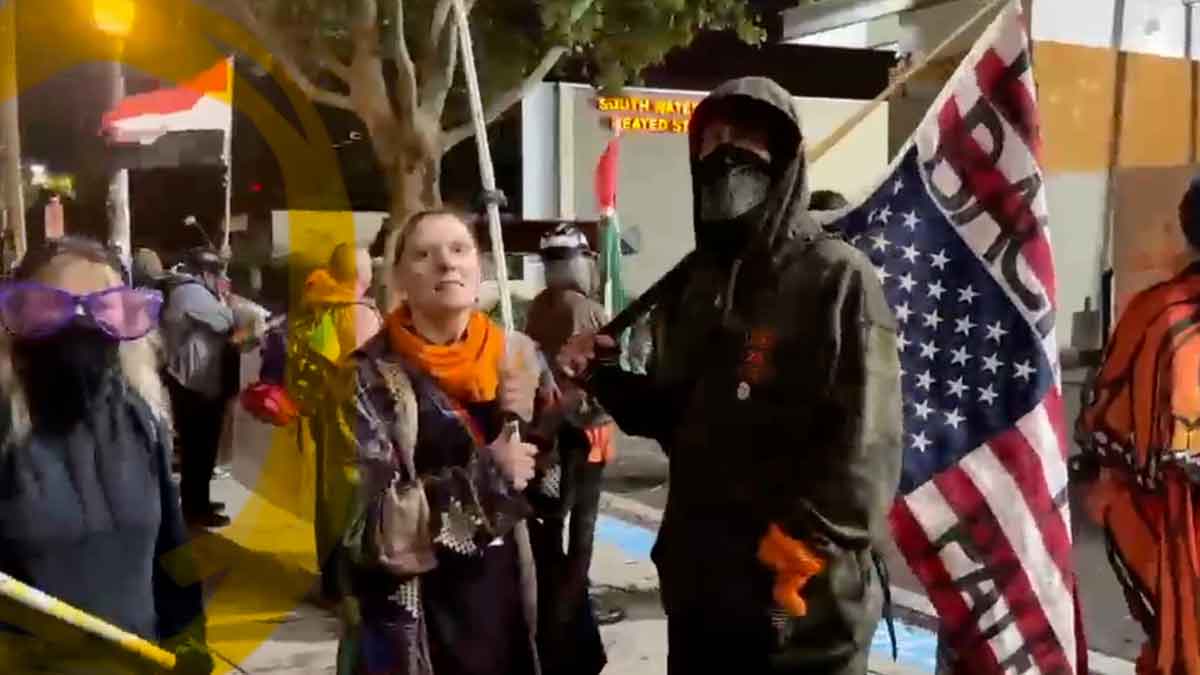Breaking News: While this article was being finalized, a federal judge blocked the White House’s request to federalize and deploy 200 Oregon National Guard soldiers to Portland.
The Incident That Sparked Outrage
[Portland, OR – WBHG News] — A newly surfaced video shows a federal agent pepper-spraying two protesters in Portland despite the individuals posing no visible threat. The incident has become the latest flashpoint in a conflict that began years ago and has since turned Portland into a symbol of the nation’s cultural and political divide.
Tensions flared Thursday when federal agents stationed outside the Immigration and Customs Enforcement (ICE) office on South Bancroft Street ordered demonstrators to move so a vehicle could exit. The crowd complied, though several voiced anger at the agents. Moments later, a federal officer stepped forward and pepper-sprayed two peaceful protesters — one identified only as Leialani, a 19-year-old activist.
Also Read
The footage, now circulating widely online, has reignited debate over federal use of force and accountability.
Breaking Down the Video
The 30-second clip provides a clear sequence of events:
-
00:03–00:09: Leialani and another protester stand calmly as two agents with shields engage them in conversation.
-
00:11–00:16: A third agent arrives, holding a can of pepper spray. A supervisor off-screen issues an order to de-escalate and withdraw.
-
00:18–00:19: Despite the instruction, the agent sprays Leialani directly in the face, then turns and sprays the second protester.
-
00:23: Leialani staggers back, blinded, dropping her phone as bystanders rush to help.
The exchange lasted less than 10 seconds but has already drawn national condemnation.
Federal Guidelines on Use of Force
According to the Federal Law Enforcement Training Centers (FLETC), pepper spray is considered an “intermediate weapon,” only to be used when a suspect poses a significant threat. The 1989 Supreme Court case Graham v. Connor established what’s known as the Graham Factor, which requires any use of force to be “objectively reasonable.”
The factors include:
-
Severity of the crime. Was the person committing or suspected of a serious offense?
-
Immediate threat. Did the suspect pose a danger to officers or others?
-
Resistance or flight. Was the suspect resisting or attempting to flee?
In this case, none of those conditions appear to have been met. The protesters were not resisting, nor were they under arrest. The supervisor had explicitly ordered the squad to disengage, making the agent’s actions a clear violation of FLETC’s own guidelines.
How Big Are the Protests, Really?
Portland, a city of about 635,000 residents, has been home to recurring demonstrations since 2018, largely focused on immigration and policing. The protests typically center on a single industrial block near the South Waterfront — a space smaller than a football field.
Despite national narratives of chaos, official data paints a different picture:
-
Since June 9, federal agents have made 130 arrests and opened 27 investigations.
-
The Portland Police Bureau has made dozens more arrests, showing an ongoing law enforcement presence.
-
Protests have rarely exceeded 100 participants, according to city and federal officials.
While nightly demonstrations have become routine, daytime operations at the ICE facility continue uninterrupted — contradicting federal claims that it is “under siege.”
Outside Agitators and the Role of Extremist Groups
Portland’s protests are often portrayed as homegrown unrest, but data shows otherwise. According to the Armed Conflict Location and Event Data Project (ACLED), Oregon ranks among the top five states at risk for militia activity, much of it originating outside Portland.
Groups such as the Proud Boys, Patriot Front, and Patriot Prayer — all based in other states — have repeatedly clashed with anti-fascist activists in Portland since 2018.
Several high-profile convictions support this pattern:
-
Alan Swinney (Texas), a Proud Boy, sentenced to 10 years for assault.
-
Tusitala “Tiny” Toese (Washington), a far-right organizer, sentenced to eight years.
-
Malik Fard Muhammad (Indiana), convicted for using Molotov cocktails during protests, sentenced to 10 years.
Data from local and federal authorities confirms that most serious offenders were not Portland residents, suggesting that ideological outsiders have been fueling much of the city’s unrest.
The Bigger Picture: Use of Force and Civil Rights
Analysts reviewing the pepper-spray video concluded it was a clear violation of federal training standards. The protesters were neither threatening nor resisting, and the officer’s decision to deploy pepper spray occurred after a withdrawal order — a move both reckless and unlawful.
The incident raises a deeper concern: when government agencies begin selectively applying laws, civil liberties erode. As one analyst noted, “History shows that when a government decides who deserves protection, democracy itself becomes fragile.”
Global Lessons from Authoritarian Trends
Recent global examples illustrate how unchecked government power can evolve into repression. In Russia, after the 2023 deaths of Wagner Group leaders Yevgeny Prigozhin and Dmitry Utkin, the Kremlin began a massive purge of so-called “turbo patriots” — once-loyal nationalists now branded as enemies of the state.
Former FSB Colonel Igor Girkin (also known as Strelkov) was sentenced to over four years in prison for a social media post criticizing military leadership. Others faced fines, imprisonment, or mysterious deaths. These purges coincided with crackdowns on journalists, teachers, LGBTQ communities, and political opposition.
The Russian case demonstrates how governments that justify overreach in the name of “order” often use the same tactics later to silence their own supporters.
Why It Matters in the United States
The parallels may feel distant, but the warning is real. Expanding federal power without accountability risks creating new enemies to justify continued control. Private detention corporations, political opportunists, and extremist factions all benefit from sustained unrest.
If these powers are normalized under one administration, they could easily be turned against its supporters under another. The same laws that enable suppression today could be weaponized tomorrow.
Final Assessment
After reviewing the evidence, it is clear that the pepper-spray incident in Portland represents a misuse of force — one that contradicts federal policy, training, and the spirit of constitutional protections.
While the city’s protests are often portrayed as chaotic, data and analysis show a limited geographic footprint and a relatively small number of active participants. The greater concern lies not in Portland’s streets, but in how the government chooses to respond.
Unchecked use of power — even in the name of security — sets a precedent that endangers democracy itself. The federal judge’s decision to block the National Guard deployment may not end the tension, but it marks a critical moment in reaffirming the balance between law, accountability, and freedom in America.












